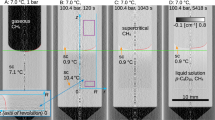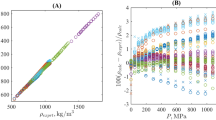Abstract
SEVERAL authors1 have suggested that included gases have an appreciable effect in lowering the observed tensile strength of a liquid. For this reason it was decided to attempt to measure the tensile strength of a low-temperature liquid which, when cooled below its normal boiling point, would contain none of the normally included gases found in most liquids.
This is a preview of subscription content, access via your institution
Access options
Subscribe to this journal
Receive 51 print issues and online access
$199.00 per year
only $3.90 per issue
Buy this article
- Purchase on SpringerLink
- Instant access to full article PDF
Prices may be subject to local taxes which are calculated during checkout
Similar content being viewed by others
References
Kuper and Trevena, Proc. Phys. Soc., 65, 46 (1952). Benson and Gerjuoy, J. Chem. Phys., 17, 914 (1949). Vincent, R. S., Proc. Phys. Soc., 55, 41 (1941).
Temperley and Chambers, Proc. Phys. Soc., 58, 421 (1946).
Vincent, R. S., Proc. Phys. Soc., 53, 126 (1941).
Bernath, L., Indust. and Eng. Chem., 44, 1310 (1952).
Temperley, H. N. V., Proc. Phys. Soc., 59, 199 (1947).
Author information
Authors and Affiliations
Rights and permissions
About this article
Cite this article
MISENER, A., HEDGCOCK, F. Tensile Strength of Liquid Nitrogen. Nature 171, 835–836 (1953). https://doi.org/10.1038/171835b0
Issue date:
DOI: https://doi.org/10.1038/171835b0



